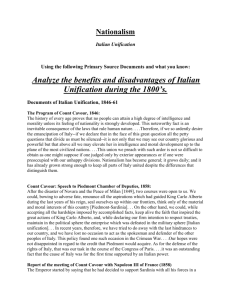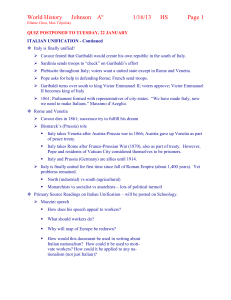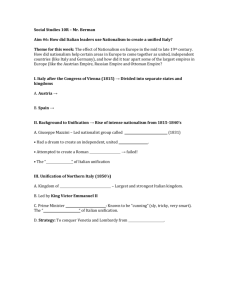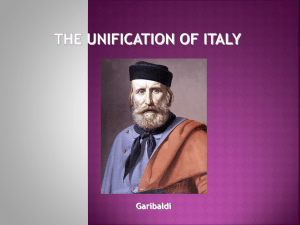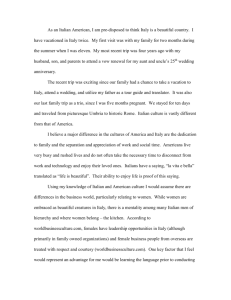The Unification of Italy - Italian
advertisement
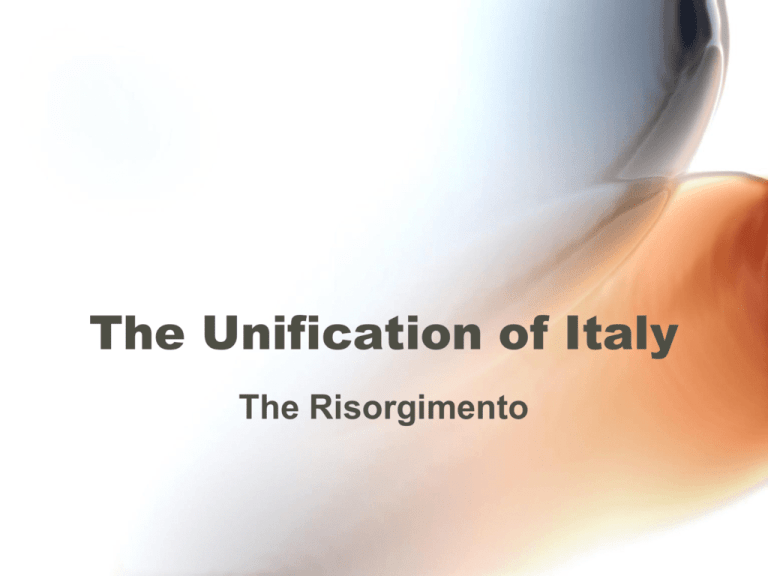
The Unification of Italy The Risorgimento Italian Unification Background • Congress of Vienna – Restoration of the pre-Napoleonic patchwork of independent governments • Groups in several Italian states began to push the idea of a unified Italian state again – the struggle for Italian unification was perceived to be waged primarily against the Austrian Empire and the Habsburgs • they directly controlled the predominantly Italianspeaking northeastern part of present day Italy and were the single most powerful force against unification • the Austrian Empire fought hard against nationalist sentiment growing on the Italian peninsula • Metternich stated that the word Italy was "purely a geographic expression." Background • Pope opposed to Italian unification – Wanted some measure of autonomy over the Papal States • Different groups could not agree on what form a unified state would take – Vincenzo Gioberti suggested a confederation of Italian states under the Pope. – Many leading revolutionaries wanted a republic – Eventually it was a king and his minister who had the power to unite the Italian states as a monarchy Early Moves • Carbonari (coal-burners) – a secret organization formed in southern Italy early in the 19th century – Inspired by the principles of the French revolution, its members were mainly drawn from the middle class and intellectuals – Carbonari spread into the Papal States, the kingdom of Sardinia, the Grand Duchy of Tuscany, the Duchy of Modena and the kingdom of Lombardy-Venetia – Many rulers decreed the death penalty for anyone who attended a Carbonari meeting – Most leaders of the unification movement were members of this organization Prominent Leaders • • • • Giuseppe Mazzini Giuseppe Garibaldi Count Cavour Victor Emmanuel II Giuseppe Mazzini Giuseppe Mazzini • A member of the Carbonari • Activity in revolutionary movements got him in trouble • Organized La giovine Italia (Young Italy) – A political society – its basic principle was the union of the several states and kingdoms of the peninsula into a single republic • Believed that Italian unification could only be achieved through a popular uprising • His importance was more ideological than practical • Credited with fashioning the political idea that Italy was a country more than a patchwork of antiquated Roman city-states • It would be others who would make this idea a reality though • Never accepted a monarchical united Italy and continued to work for a democratic republic Giuseppe Garibaldi Giuseppe Garibaldi • In 1833, met Giuseppe Mazzini • Joined the Young Italy movement and the Carbonari revolutionary association • In February 1834 he participated in a failed Mazzinian insurrection in Piedmont, was sentenced to death, and fled • Garibaldi left for Brazil and took up the cause of independence of the Republic of Rio Grande do Sul • Joined the rebels against the newly independent Brazilian nation • Returned to Italy in 848 – served the king of Sardinia – after disagreements, he & followers crossed into Lombardy where they offered assistance to the provisional government of Milan • Roman Republic under threat from French forces – Garibaldi took up the command of the defense of Rome – city fell on June 30, 1849 – Garibaldi was forced to flee • Moved to the USA then to the UK Count Camillo di Cavour Count Camillo di Cavour • In 1847, became a political journalist with his newspaper Il Risorgimento in Turin • Gave a speech in front of many journalists in favor of a constitution for Piedmont, which was eventually granted • Never really favoured the establishment of a united country – favored an expanded Piedmont rather than a unified Italy – like most Italians he resented the control that Austria had over the country • when an uprising in Milan against the Austrians occurred in 1849, Cavour was one of many who advocated the war that followed as the chance to expell the Austrians once and for all • the war was unsuccessful for the Piedmontese • Cavour was finally brought in to the Chamber of Deputies, sitting on the right as a conservative • gained a reputation as a non-revolutionary progressive • Cavour lost an election but was then brought back into Parliament • Cavour soon came to dominate the cabinet • Became Prime Minister of Piedmont on 4 November 1852 Victor Emmanuel II Victor Emmanuel II • Became king of Sardinia-Piedmont in 1849 – father abdicated after an overwhelming military defeat by the Austrians – Victor Emmanuel was immediately able to obtain a rather favorable armistice at Vignale by the Austrian commander – In 1849 he also fiercely suppressed the revolt in Genoa, defining the rebels as a "vile and infected race of cowards • In 1852 Victor Emmanuel II gave Count Camillo di Cavour the title of Prime Minister • Victor Emmanuel II soon became the symbol of the Italian Risorgimento 1830 • Rrevolutionary sentiment in favor of a unified Italy began to grow • Insurrections took place throughout the Papal States – Chose the tri-color as their flag • Insurrected provinces planned to unite as the Province Italiane unite – Pope Gregory XVI asked for Austrian help against the rebels • Spring of 1831 – Austrian army began its march across the Italian peninsula – crushed resistance in each province that had revolted 1848 • Revolutions all over Italy • Results – No change War of 1859 • Sardinia-Piedmont still sought expansion across Italy – Cavour saw that Piedmont would not be able to do it alone – hoped to secure aid from Britain and France in expelling the Austrians • Attempted to gain western favor by supporting them in the Crimean War – not successful – Italian matters were ignored at the Congress of Paris • On January 14, 1858, an Italian nationalist Felice Orsini attempted to assassinate Napoleon III – In a plea written from his prison cell, Orsini appealed to Napoleon III to fulfill his destiny by aiding the forces of Italian nationalism – Napoleon III became convinced that it was his destiny to do something for Italy • Summer of 1858 – Cavour met with Napoleon III and signed a secret agreement – agreed to a joint war against Austria – Piedmont would gain the Austrian territories in Italy (Lombardy and Venetia), as well as the Duchies of Parma and Modena – France would be rewarded with Piedmont's transalpine territories of Savoy and Nice – Cavour was to provoke the Austrians into aggression by encouraging revolutionary activity in Lombardy War of 1859 • The Austrians were surprisingly patient in dealing with the Piedmontese-inspired insurrections • The Piedmontese mobilization in March 1859 was then something of an admission of defeat • Without Austrian aggression, the French could not intervene, and without French support, Cavour was unwilling to risk war • At this time however, the Austrians conveniently made their opponents' task easier by sending an ultimatum to the Piedmontese demanding demobilization • This the Piedmontese could conveniently reject and, by making Austria seem the aggressor, allowed the French to intervene War of 1859 • The war itself was quite short • Battle of Magenta – French and Sardinians were victorious over the Austrian army – Austrians withdrew from most of Lombardy • Battle of Solferino – bloody engagement – French were again victorious – Austrians withdrew behind the Quadrilateral of fortresses on the borders of Venetia Results of War of 1859 • Napoleon III meets with Franz Josef – Sardinia-Piedmont takes Lombardy, no other changes • Smaller northern Italian states form the United Provinces of Central Italy – Napoleon III agrees to their incorporation into Sardinia-Piedmont after compensation of Savoy and Nice being transferred to France 1860 • Only four states remain in Italy – Sardinia-Piedmont – Venetia – Papal States – Kingdom of the Two Sicilies Initial Unification • Garibaldi invades Sicily and takes control of the island in short order • After consolidation of power in Sicily, Garibaldi invades the mainland – Takes Naples, the capital of the Two Sicilies – Still not able to completely defeat the army of the Two Sicilies – Calls for help from Sardinia-Piedmont • To reach the Two Sicilies, the army of Sardinia-Piedmont was required to go through the Papal states – Initial agreement was given for this – However, Papal army resisted and was defeated Initial Unification • Combined army of Garibaldi and Victor Emmanuel finally defeats the army of the Two Sicilies – King of Two Sicilies abdicates • Two Sicilies united with SardiniaPiedmont in an Italian state – Only Papal States and Venetia remain outside the union Moves on Rome • French troops staioned in Rome to support the pope • Garibaldi demands that Italian state attack Rome – Italy refuses • Garibaldi, with 2,000 volunteers moves on Rome but is barred by Italian troops • Victor Emmanuel II reaches agreement with Napoleon III for French to leave by 1866 Austro-Prussian War • Italy supports Prussia – Invades Venetia in 1866 – Defeated in battles both on land and on sea • With defeat of Austria in the war – Italy awarded Venetia • Only Rome stayed outside of a united Italy Rome • French troops move back into Rome • Various threats to Rome by Italian groups from 1866 – 1870 • With the outbreak of the FrancoPrussian War of 1870, France returns troops to France to fight in the war • Italy takes Rome after French defeat at Sedan • Pope withdraws inside Vatican • Rome becomes capital of Italy
